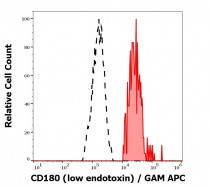ARG42261
anti-CD180 / RP105 antibody [G28-8] (low endotoxin)
anti-CD180 / RP105 antibody [G28-8] (low endotoxin) for Flow cytometry,Functional study,Immunoprecipitation and Human
Overview
| Product Description | Azide free and low endotoxin Mouse Monoclonal antibody [G28-8] recognizes CD180 / RP105 |
|---|---|
| Tested Reactivity | Hu |
| Tested Application | FACS, FuncSt, IP |
| Specificity | The mouse monoclonal antibody G28-8 recognizes an extracellular epitope of CD180, a 95-105 kDa TLR-like glycoprotein expressed on peripheral blood monocytes and dendritic cells, mantle zone B cells and marginal zone B cells, but very weakly on germinal center B cells. |
| Host | Mouse |
| Clonality | Monoclonal |
| Clone | G28-8 |
| Isotype | IgG1, kappa |
| Target Name | CD180 / RP105 |
| Antigen Species | Human |
| Immunogen | Human tonsillar B cells. |
| Conjugation | Un-conjugated |
| Alternate Names | LY64; Radioprotective 105 kDa protein; CD180 antigen; CD antigen CD180; Lymphocyte antigen 64; RP105; Ly78 |
Application Instructions
| Application Suggestion |
|
||||||||
|---|---|---|---|---|---|---|---|---|---|
| Application Note | * The dilutions indicate recommended starting dilutions and the optimal dilutions or concentrations should be determined by the scientist. |
Properties
| Form | Liquid |
|---|---|
| Purification | Purification with Protein A. |
| Purification Note | 0.2 µm filter sterilized. Endotoxin level is <0.01 EU/µg of the protein. |
| Buffer | PBS |
| Concentration | 1 mg/ml |
| Storage Instruction | For continuous use, store undiluted antibody at 2-8°C for up to a week. For long-term storage, aliquot and store at -20°C or below. Storage in frost free freezers is not recommended. Avoid repeated freeze/thaw cycles. Suggest spin the vial prior to opening. The antibody solution should be gently mixed before use. |
| Note | For laboratory research only, not for drug, diagnostic or other use. |
Bioinformation
| Database Links | |
|---|---|
| Gene Symbol | CD180 |
| Gene Full Name | CD180 molecule |
| Background | CD180 is a cell surface molecule consisting of extracellular leucine-rich repeats (LRR) and a short cytoplasmic tail. The extracellular LRR is associated with a molecule called MD-1 and form the cell surface receptor complex, RP105/MD-1. It belongs to the family of pathogen receptors, Toll-like receptors (TLR). RP105/MD1, by working in concert with TLR4, controls B cell recognition and signaling of lipopolysaccharide (LPS), a membrane constituent of Gram-negative bacteria. [provided by RefSeq, Jul 2008] |
| Function | May cooperate with MD-1 and TLR4 to mediate the innate immune response to bacterial lipopolysaccharide (LPS) in B-cells. Leads to NF-kappa-B activation. Also involved in the life/death decision of B-cells (By similarity). [UniProt] |
| Cellular Localization | Cell membrane; Single-pass type I membrane protein. [UniProt] |
| Calculated MW | 74 kDa |
Images (2) Click the Picture to Zoom In
-
ARG42261 anti-CD180 / RP105 antibody [G28-8] (low endotoxin) FACS image
Flow Cytometry: Human peripheral blood stained with ARG42261 anti-CD180 / RP105 antibody [G28-8] (low endotoxin) at 6 µg/ml dilution, followed by APC-conjugated Goat anti-Mouse antibody.
-
ARG42261 anti-CD180 / RP105 antibody [G28-8] (low endotoxin) FACS image
Flow Cytometry: Separation of Human CD180 positive lymphocytes (red-filled) from CD180 negative lymphocytes (black-dashed). Human peripheral whole blood stained with ARG42261 anti-CD180 / RP105 antibody [G28-8] (low endotoxin) at 6 µg/ml dilution, followed by APC-conjugated Goat anti-Mouse antibody.







